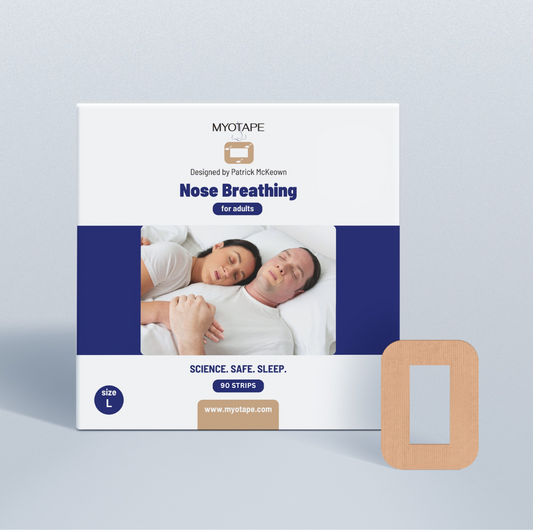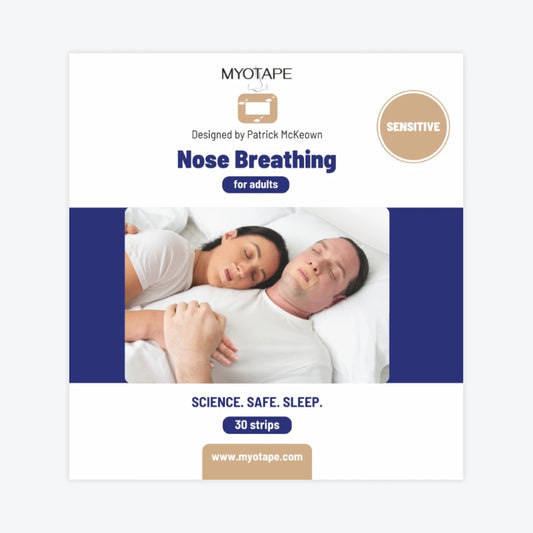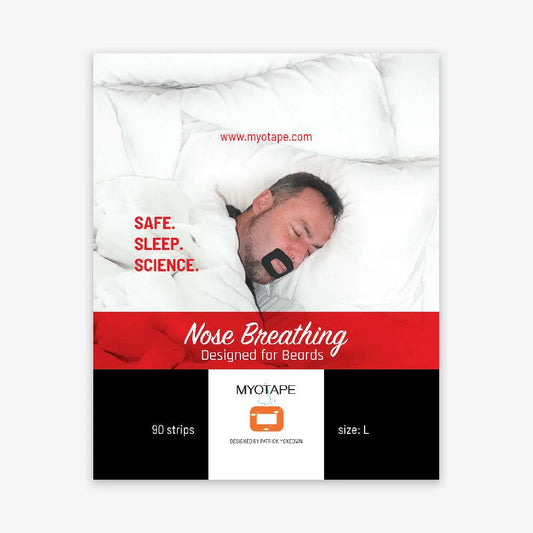If you are a parent, you know how important a good night’s sleep is for your child. Maybe you have noticed your child snoring, breathing through their mouth, or waking up tired.
Now you are searching for simple ways to help them sleep better. You might have heard about using mouth tape for kids and wondered if it could help.
It is natural to have questions like, can you use mouth tape on kids, is mouth tape good for kids, or could it be risky? You want the best for your child, but you also want to make safe choices.
In this article, we will address your questions, explain what mouth taping is, discuss the potential benefits of mouth taping for children, and outline the safety concerns every parent should be aware of.
What is Mouth Taping and Why Do Parents Consider It?
Mouth taping is a simple idea: a gentle, skin-friendly strip is placed around the lips to help keep the mouth closed during sleep or while awake.
The goal is to help children keep their mouths closed while they sleep and encourage them to breathe through their nose instead of their mouth. Some parents also try mouth taping for snoring kids in hopes of quieter nights and better rest.
Please note: Children under the age of 4 should not use mouth tapes and talk to your doctor first.
It is also important to note that mouth breathing in children can occur for various reasons, and it is best to determine the cause first by consulting with a healthcare professional.
Research suggests that mouth taping can help with stopping mouth breathing in children. For example, a 2020 study involving over 300 children found that most kids, even those who usually breathe through their mouths, could comfortably breathe through their noses when their mouths were gently taped for a few minutes.
This indicates that, for many children, mouth breathing is a habit that can be altered with the right support. But why is nose breathing so crucial for kids, and why is mouth breathing bad for them?

Why Does Nose Breathing Matter for Kids?
Breathing through the nose may seem like something every child does or is supposed to do, but in reality, many children breathe through their mouths instead.
This is more common than most parents realize, and it can have a real impact on your child’s health and daily life.
Benefits of nose breathing for kids:
- Fewer illnesses: The nose filters and moistens the air, helping protect your child from coughs, colds, and respiratory infections.
- Better sleep: Nasal breathing reduces snoring and nighttime awakenings, helping your child sleep well, wake up feeling rested and ready for the day.
- Improved concentration: Proper nasal breathing brings more oxygen to the brain, supporting focus and learning at school and during activities.
- Healthier teeth and jaws: Breathing through the nose helps keep the mouth moist and supports the proper development of the teeth and jaw, thereby lowering the risk of cavities and orthodontic problems.
- Fresher breath: Nasal breathing keeps the mouth from drying out, which helps prevent bad breath and supports good oral hygiene.
Risks of mouth breathing in children:
- More frequent illnesses: Mouth breathing allows unfiltered air into the lungs, increasing the risk of infections and sore throats.
- Poor sleep quality: Children who breathe through their mouths are more likely to snore and wake up feeling tired, which can impact their mood and energy levels.
- Dental problems: Mouth breathing can cause the mouth to dry out, leading to bad breath, cavities, and changes in the growth of teeth and the jaw.
- Difficulty focusing: Poor sleep and less oxygen to the brain can make it harder for your child to concentrate and do well in school.
However, encouraging your child to breathe through their nose is a simple yet effective way to support their health, sleep, and overall development. This is where mouth taping comes in as an aid.
Potential Benefits of Mouth Taping for Kids
Mouth taping can help children learn to breathe through their nose, not just while they sleep but also during the day. This practice may offer several benefits:
- Promotes nasal breathing: Mouth taping helps children become accustomed to breathing through their nose, which supports better airway health and reduces the risk of respiratory infections.
- Reduces snoring: Many parents find that children snore less when they breathe through their nose, making nights quieter for everyone.
- Improves sleep quality: Nasal breathing can lead to deeper, more refreshing sleep, which is essential for your child’s learning, growth, and play.
- Supports oral health: Keeping the mouth closed helps maintain healthy saliva flow, protecting teeth and gums, and lowering the chance of cavities and bad breath.
- Encourages healthy facial development: Regular nasal breathing helps the jaw and face grow properly, which can benefit your child’s dental and airway health in the long run.
- Trains kids to stop mouth breathing: Using mouth tape can help children break the habit of mouth breathing, supporting better health both day and night.
Does that make mouth taping safe for all kids? Let’s find out.

Is Mouth Taping Safe for Kids?
Mouth taping is not safe for every child and should always be approached with caution. Children have smaller and more sensitive airways, which means any risk of blocked breathing can be serious.
Children under four should never use mouth tape and should always consult their doctor first. Older children should only use tapes made specifically for kids, and only under close adult supervision.
Main safety concerns include:
- Breathing difficulties: If your child has nasal congestion, a blocked nose, allergies, or sinus issues, taping the mouth can make it hard to breathe and may even become dangerous. Always check that your child can breathe easily through their nose before considering mouth taping.
- Skin irritation: The adhesive can cause redness, rashes, or allergic reactions, especially on sensitive skin around the mouth. Use only hypoallergenic tapes specifically designed for children.
- Anxiety or distress: Some children may feel anxious or panicked with their mouth taped, which can disrupt sleep or cause emotional discomfort.
- Emergency situations: Kids may not be able to remove the tape quickly if they feel sick or have trouble breathing during the night.
Also, mouth taping should not be used for children with sleep apnea, frequent nasal blockages, or those prone to nausea or vomiting. Never use regular household or duct tape, as it can damage the skin and is difficult to remove in an emergency. See more safety tips for mouth taping.
MyoTape for kids is the safest and best mouth tape for children. It is designed to be safer by allowing some mouth movement. Nonetheless, if you are considering mouth taping for your child, always consult a medical professional first to make sure it is safe and appropriate for your child’s specific needs.
How to Safely Try Mouth Taping for Kids
If you are considering mouth taping to help your child develop better nasal breathing habits, safety should always be your top priority. Here are important steps and tips to make the process safe and comfortable for your child:
1. Always consult a doctor first
Before starting mouth taping, talk to your child’s doctor or dentist. This is especially important if your child has any breathing difficulties, allergies, or other health concerns.
2. Choose MYOTAPE
Never use household tape, any non-medical adhesive, or duct tape on your kid’s mouth. Only use mouth tapes made for children, such as MYOTAPE.
MYOTAPE is designed to gently bring the lips together without fully sealing the mouth, which allows for mouth puffing if needed. Look for hypoallergenic and skin-friendly options on the MyoTape shop to reduce the risk of irritation.
3. Make sure nasal passages are clear
Test your child’s ability to breathe through their nose before taping. Have your child sit quietly and breathe through their nose for a few minutes. If they struggle, try simple nose unblocking exercises or Buteyko breathing exercises for kids to help improve nasal breathing. Address any congestion or allergies before using mouth tape.
4. Start slowly and supervise
Begin with short sessions of about 20 to 30 minutes while your child is distracted with a calm activity such as reading, watching TV, or playing on a tablet. This helps your child get used to the feeling without stress. You can gradually increase the time as they become more comfortable.

5. Apply the tape correctly
Make sure the skin around the mouth is clean and dry before applying the tape. Apply the tape vertically from the nose to the chin for easier removal and to allow for some mouth movement. The tape should feel secure but not tight. Always keep a corner of the tape loose for quick removal if needed.
6. Monitor closely
Supervise your child the entire time they are wearing the tape. Watch for any signs of discomfort, anxiety, or trouble breathing. Remove the tape immediately if your child feels uncomfortable or is having difficulty breathing.
7. Use positive reinforcement
Encourage your child by pairing mouth taping with something they enjoy, such as screen time, to help them feel more comfortable with the new habit.
Give Your Child the MyoTape Advantage
Healthy nose breathing can transform your child’s sleep, focus, and overall health. MyoTape is the safest and most effective mouth tape for kids.
It was created by breathing expert Patrick McKeown and designed just for children. MyoTape gently trains the lips to stay closed without sealing the mouth, allowing your child to breathe easily and safely at all times. The mouth strips are hypoallergenic, comfortable, and easy to remove.
Help your child sleep better, feel better, and thrive. Get MyoTape for kids today and see the difference. Shop now for the safest mouth tape made just for children.








